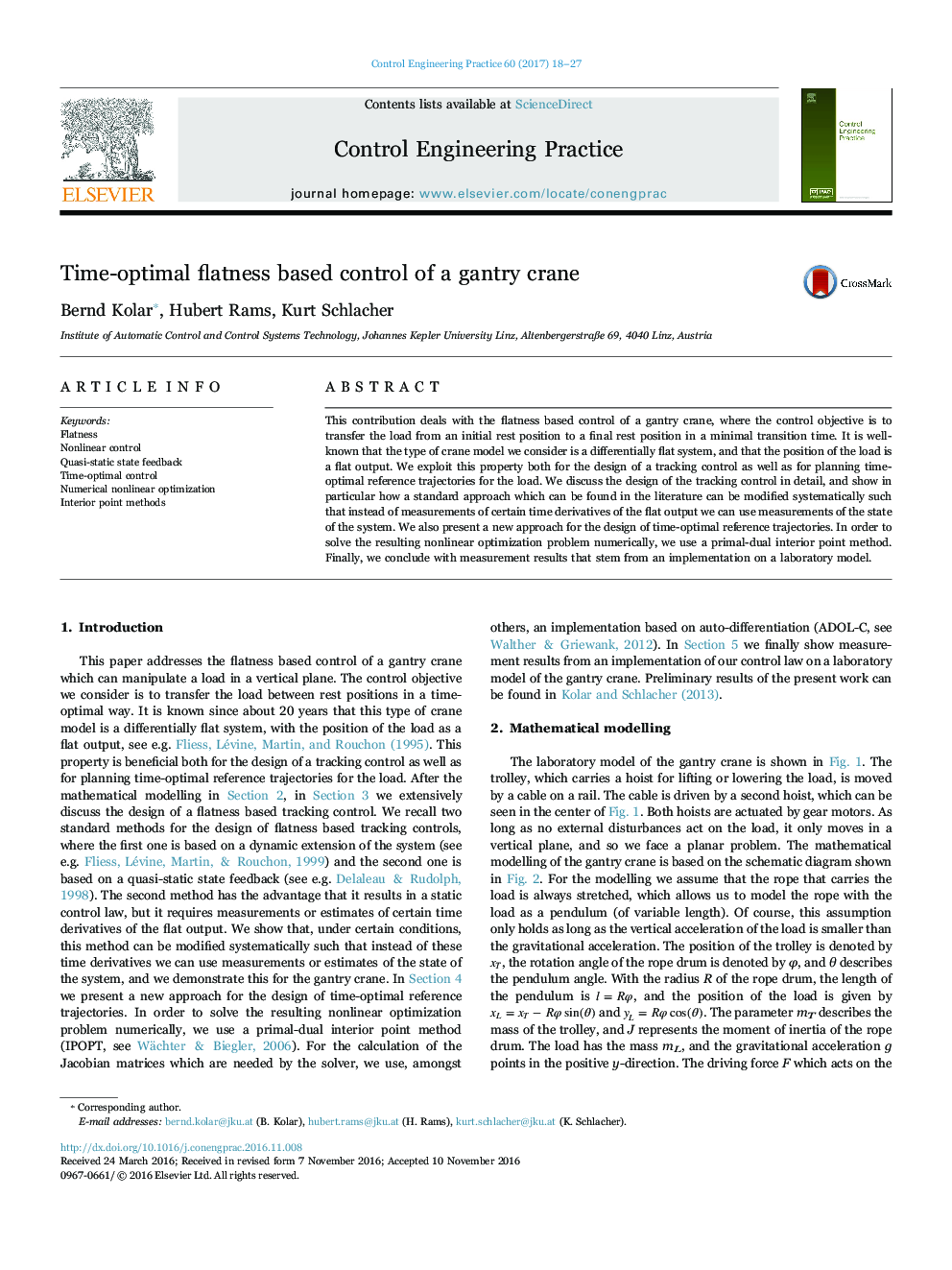| کد مقاله | کد نشریه | سال انتشار | مقاله انگلیسی | نسخه تمام متن |
|---|---|---|---|---|
| 5000393 | 1460686 | 2017 | 10 صفحه PDF | دانلود رایگان |
عنوان انگلیسی مقاله ISI
Time-optimal flatness based control of a gantry crane
ترجمه فارسی عنوان
کنترل دقیق زمان دقیق بر پایه یک جرثقیل فرعی
دانلود مقاله + سفارش ترجمه
دانلود مقاله ISI انگلیسی
رایگان برای ایرانیان
کلمات کلیدی
تخت کنترل غیرخطی بازخورد حالت نیمه استاتیک، کنترل زمان بهینه، بهینه سازی غیر خطی عددی، روش های داخلی،
ترجمه چکیده
این همکاری با کنترل بر پایه ی یک جرثقیل فرعی است که هدف کنترل آن انتقال بار از یک موقعیت استراحت اولیه به حالت استراحت نهایی در یک زمان انتقال حداقل است. به خوبی شناخته شده است که مدل مدل جرثقیل ما در نظر گرفته شده یک سیستم تفاضلی صاف است و موقعیت بار یک خروجی صاف است. ما از این ویژگی برای طراحی یک کنترل ردیابی و همچنین برای برنامه ریزی مسیرهای مرجع بهینه برای بار استفاده می کنیم. ما در مورد طراحی کنترل ردیابی در جزئیات بحث می کنیم و به ویژه نشان می دهیم که چگونه یک رویکرد استاندارد که در ادبیات یافت می شود می تواند به طور سیستماتیک اصلاح شود به طوری که به جای اندازه گیری مشتقات زمان مشخص خروجی صاف ما می توانیم از اندازه گیری های دولت استفاده کنیم از سیستم ما همچنین یک روش جدید برای طراحی مسیرهای مرجع بهینه را ارائه می دهیم. برای حل مسئله بهینه سازی غیرخطی به صورت عددی، از یک روش نقطه اولیه داخلی دو بعدی استفاده می کنیم. در نهایت، ما با نتایج اندازه گیری نتیجه گیری از یک پیاده سازی در یک مدل آزمایشگاهی نتیجه می گیریم.
موضوعات مرتبط
مهندسی و علوم پایه
سایر رشته های مهندسی
مهندسی هوافضا
چکیده انگلیسی
This contribution deals with the flatness based control of a gantry crane, where the control objective is to transfer the load from an initial rest position to a final rest position in a minimal transition time. It is well-known that the type of crane model we consider is a differentially flat system, and that the position of the load is a flat output. We exploit this property both for the design of a tracking control as well as for planning time-optimal reference trajectories for the load. We discuss the design of the tracking control in detail, and show in particular how a standard approach which can be found in the literature can be modified systematically such that instead of measurements of certain time derivatives of the flat output we can use measurements of the state of the system. We also present a new approach for the design of time-optimal reference trajectories. In order to solve the resulting nonlinear optimization problem numerically, we use a primal-dual interior point method. Finally, we conclude with measurement results that stem from an implementation on a laboratory model.
ناشر
Database: Elsevier - ScienceDirect (ساینس دایرکت)
Journal: Control Engineering Practice - Volume 60, March 2017, Pages 18-27
Journal: Control Engineering Practice - Volume 60, March 2017, Pages 18-27
نویسندگان
Bernd Kolar, Hubert Rams, Kurt Schlacher,
